Dive How To Rezise Photo Blog Divi
Beaver Builder vs Divi: Both have been major players in the frontend WordPress page builder plugin race for quite a few years. More page builders have since joined the ranks, but these two solutions continue to thrive and innovate as WordPress and the entire web development industry changes.

We're going to take a look at each of these solutions in this post. We'll start by looking at each builder's editor before going over their themes, templates and pricing options.
And if you're considering Elementor as your page builder of choice, make sure your read our Beaver Builder vs. Elementor guide!
Our team at WP Buffs is dedicated to helping website owners, agency partners, and freelancer partners pick and set up the right WordPress page builders 24/7. Whether you need us to manage 1 website or support 1000 client sites, we've got your back.
Beaver Builder vs Divi Overview ℹ️
Let's start with an overview of each plugin. Beaver Builder and Divi are direct competitors in that they both offer their own themes designed specifically for each page builder's framework.
Let's see how each plugin and the companies that develop them differ from one another. This will give us a good foundation to compare Beaver Builder vs Divi to see which generally will be a better fit for you.
Beaver Builder 🏗️
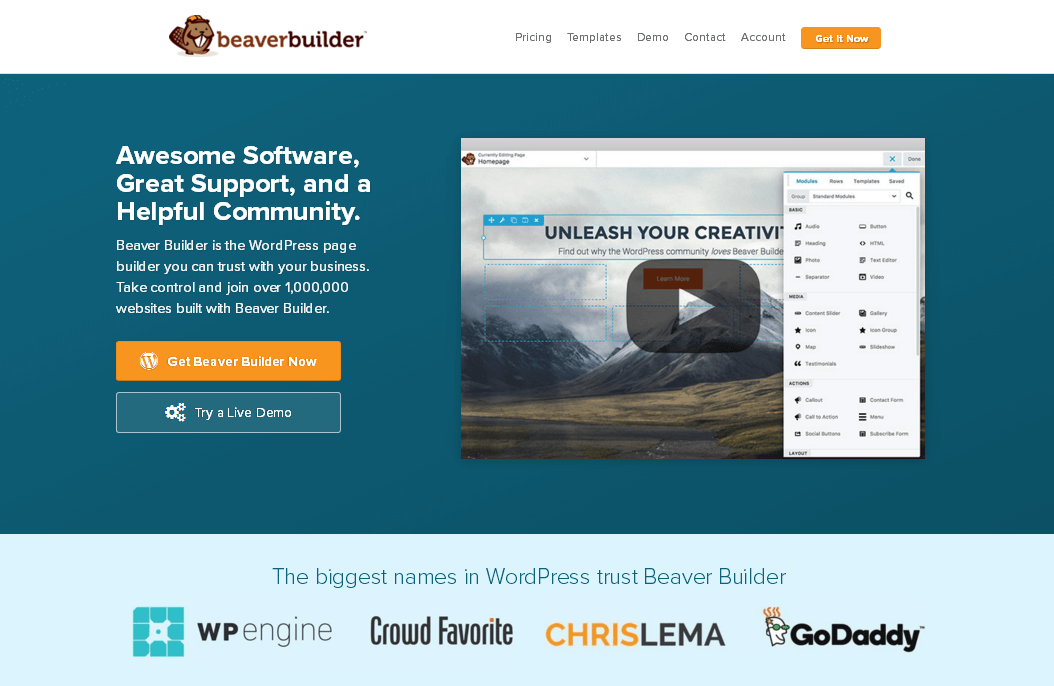
Beaver Builder became one of the first frontend WordPress page builders* when it launched in 2014. It powers over 1 million websites and its free version maintains a 4.8 average star rating on WordPress.org, proving its dependability and satisfaction among its user base.
🔌 Beaver Builder is a freemium plugin. You can get started for free by installing the plugin directly from the Add New Plugin page in the #WordPress admin. Click To TweetThe three premium plans have more of everything, but there's no difference among the premium plans in access to the entire set of premium content modules and layout templates to design beautiful sites. The higher premium plans add the Beaver Builder Theme plus agency features such as multisite functionality and white labeling. All plans allow installation on an unlimited number of sites.
Give their blog post about WordPress maintenance services a read!
Robby McCullough of Beaver Builder actually appeared on the WPMRR podcast and offered up insights on how he prepared for a year of digital nomadism. You'll definitely want to check that out!
Divi 🔧

Divi has become Elegant Themes' flagship product. It was released in 2013. While Beaver Builder originated as a plugin, Divi originated as a full WordPress theme that had a page builder built into it.
That page builder was extracted from the Divi theme in 2015 when Elegant Themes launched the Divi Builder, a standalone page builder plugin. Now both Beaver Builder and Divi can be used with virtually any theme.
Divi is a premium product, so you aren't able to use it without paying for a license. The theme or plugin, whichever version you decide to go with, comes with every feature available no matter which license type you choose. Like Beaver Builder, these include easy-to-use modules and well-designed templates.
Let's dig a little deeper to see specifically how these solutions differ from one another.
What Do These Editors Have to Offer? 🤷🏽
We'll compare these editors against one another by looking at the structures they use, the modules they offer, and module settings, as well as advanced customization options.
We'll go over templates, themes, and pricing in the next couple of sections. These core features will help you continue to decide which page builder will be best for you in your Beaver Builder vs Divi selection.
Structure
Beaver Builder uses a frontend editor, so you see every change as you make it. You can use the editor on pages, posts, and custom post types. You can start from scratch or import a template and tweak its layout and content.
Either way, when you want to add new content to your page, you'll add what Beaver Builder calls "rows" to your layout. You can place several columns in these rows, vertically and horizontally. They act as containers for the content modules you'll add to your page.
The editor has nine column frameworks to choose from, shown in this screenshot, but you can add or remove columns as you please and even resize them right on the page to your liking.
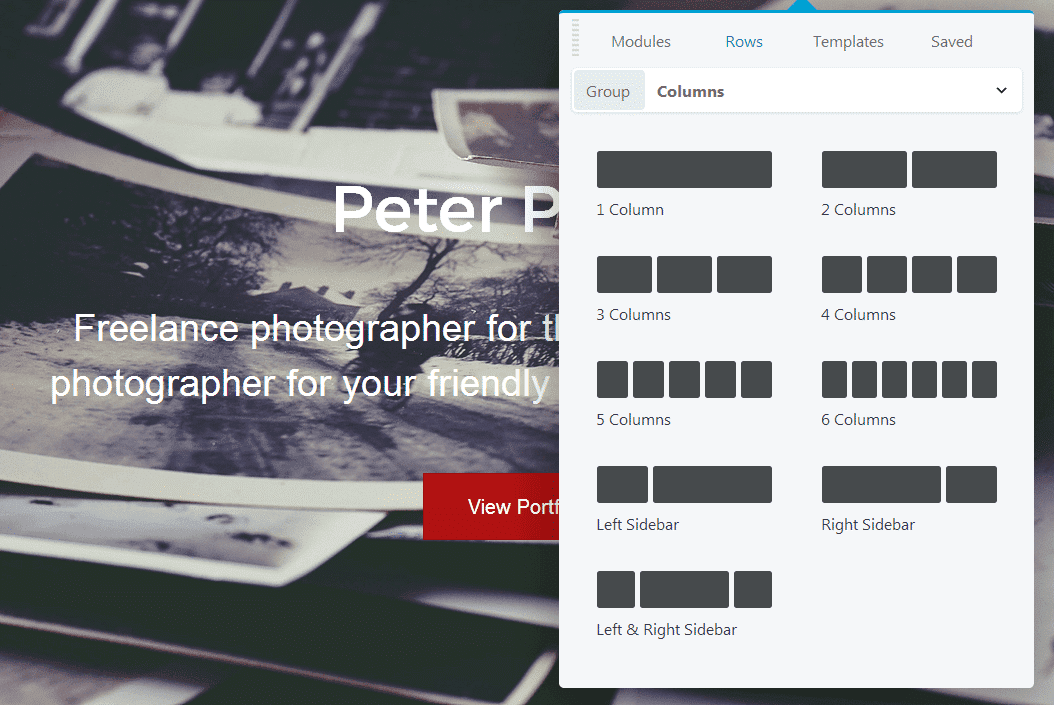
The Divi Builder can be used either on the frontend using the visual builder or on the backend by overriding the WordPress standard editor. Either way, you can use the editor on pages, posts, and custom post types.
The editor is similar to Beaver Builder in that you build your pages in sections that feature rows, add columns to those rows, and add modules to the columns. There are 20 column templates to choose from, shown in this screenshot.
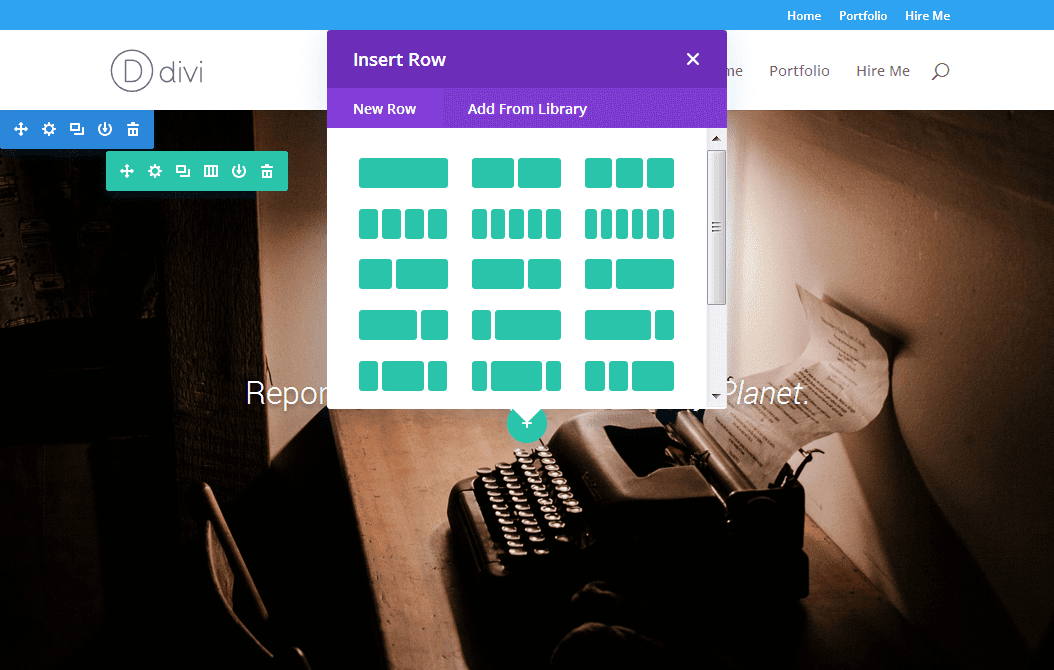
You can resize the columns as you please.
WordPress Page Builder Content Modules
Beaver Builder offers about 30 basic modules, which it organizes into six different categories, plus a set of WordPress widget modules, which let you add WordPress widgets anywhere in your content layout. The Basic modules are standard content elements, such as headings, text, video, buttons, and an HTML module that inserts code and markup directly into the rendered HTML page.
There's also a dedicated Call to Action module in the Actions category. This module has a heading, text editor, and button built into it, allowing you to add calls to action to your page efficiently. The Callout form includes all of that plus an optional image.
The Contact Form and Subscribe Form are additional modules you can use to encourage potential leads to take action on your pages.
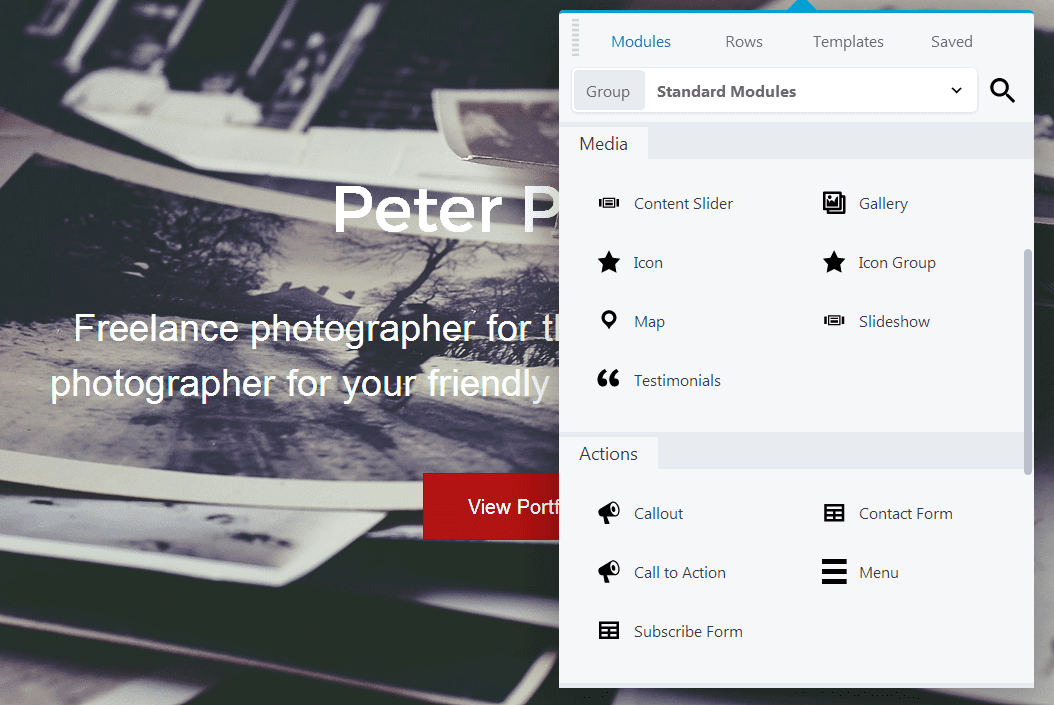
The Media category has modules you can use to add testimonials, galleries, maps, sliders, and Font Awesome icons to your page. The screenshot above shows modules in the Media and Actions categories.
You can display data, images and other information with the modules in the Layout category, which includes a pricing table and a Sidebar module that lets you add any of the WordPress sidebars defined in your theme.
The last two categories have post-based modules you can use to add blogrolls to your pages in various ways, in addition to countdown and counter elements.
Divi's modules are not categorized but instead appear in an alphabetized list, shown in the following screenshot.
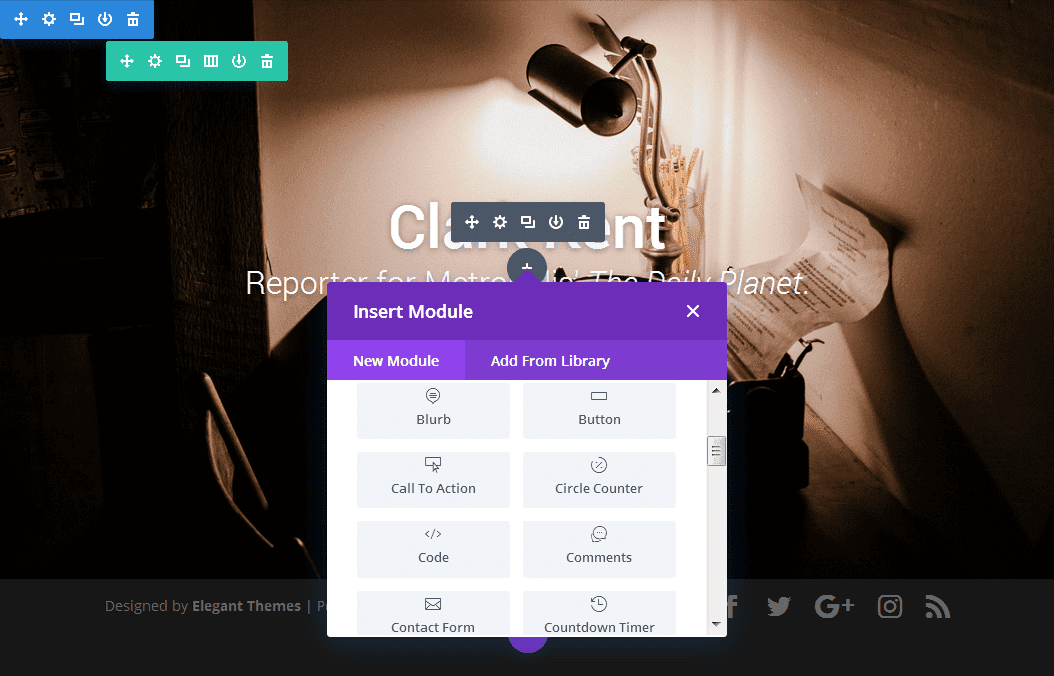
Divi has no separate Heading module. Instead, you add headings to the text editor module. While not a huge issue, it can make the building process a little tedious. You also can't add WordPress widgets to Divi Builder in the same way you can with Beaver Builder. And you can't add your theme's sidebars in the Divi Builder content layout.
Other than that, these two editors aren't very different. They offer many of the same modules but handle them differently. For example, Beaver Builder offers a single Number Counter module you can configure to use only numbers, a circle counter or a bars counter whereas Divi offers a different module for each one.
Both editors have modules for third-party plugins such as WooCommerce, which become available when you have WooCommerce installed. These modules allow you to display products on your regular pages in various ways.
Styling
In Beaver Builder, every module has settings you can configure, divided into tabs that relate to the module's specific content and features or its style, such as colors, font, and alignment. You can adjust colors with a built-in color picker or by specifying a hex or RGBA value. Custom fonts are integrated via Google, or you can add other web fonts with a little code. This screenshot shows part of the Style tab for a Button module.
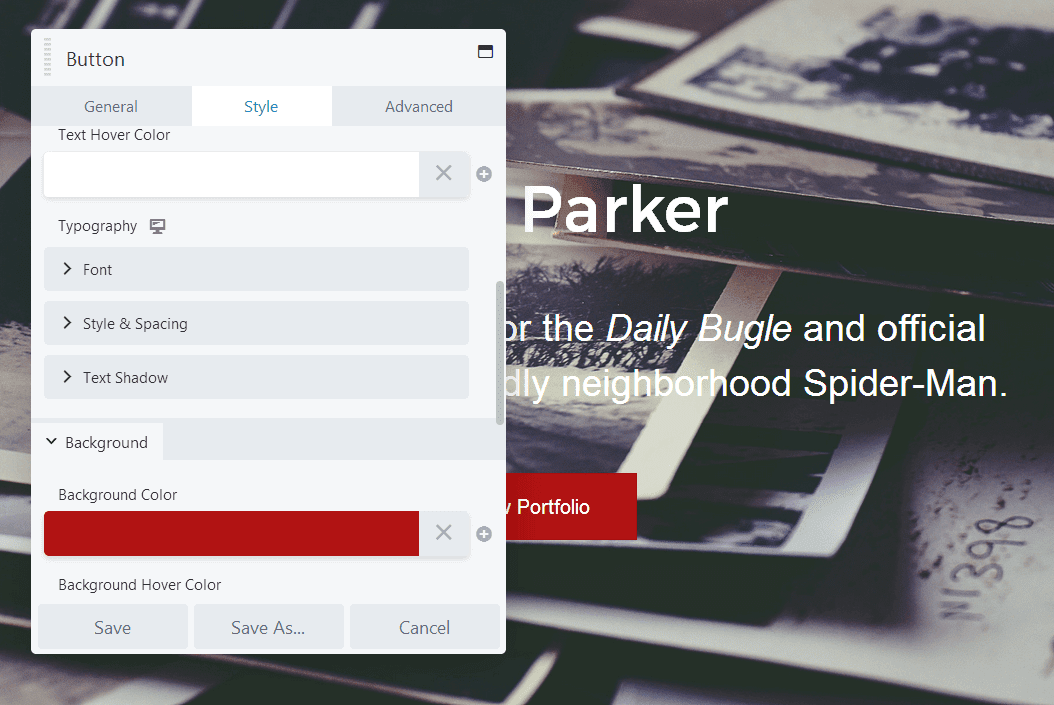
For rows, you can customize the background by adding a color, color gradient, image, video, or slideshow, plus you can add a border and edge effects that change the look of the horizontal row boundary. Columns have more restricted but similar settings.
For Divi modules, the Content section is appropriately named because it's where you'll add and configure the content you want to add to your module. You'll customize your module's styles in the Design section.
Every module has at least one unique setting. For example, the Blurb module has a setting you can use to customize the image or icon the element uses.
The settings for most Divi modules include text settings, which you can use to customize fonts, text colors and alignment, width and height settings, and margin and padding settings.
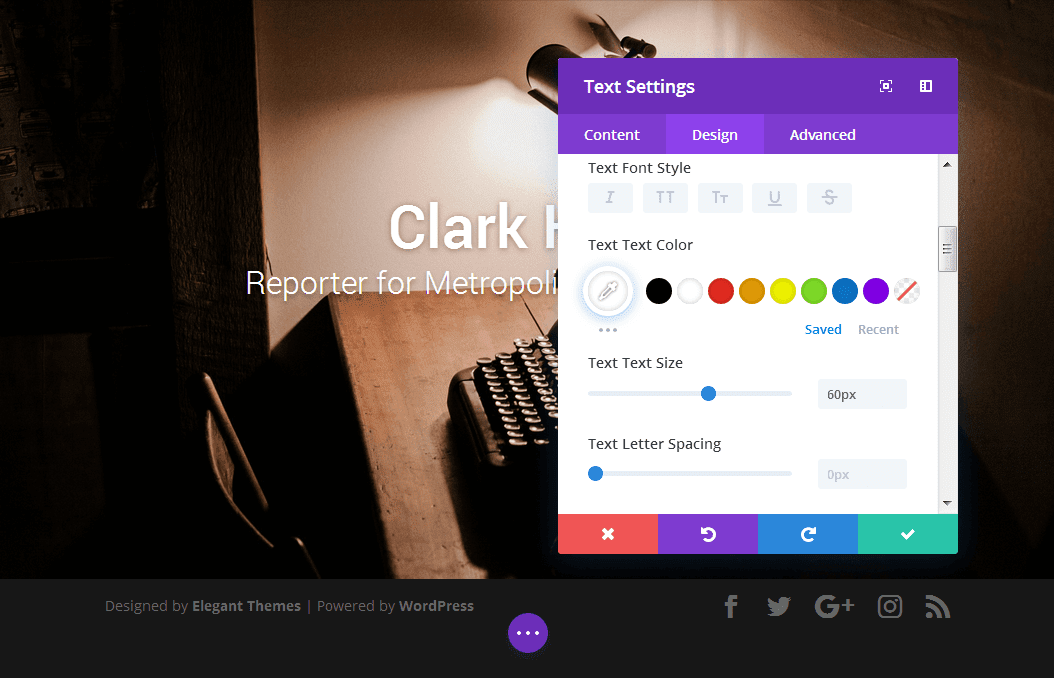
You can also customize borders, box shadows, and animations in this section. Filters can be applied as well, including filters for saturation, brightness, contrast and sepia tone.
Advanced Customization Options
Almost every Beaver Builder row, column, and module has the same Advanced tab, which contains settings you can use to configure the way the item appears and behaves beyond basic styling.
These include setting margins and padding with the ability to set different values depending on device size. The HTML settings allow you to select the type of HTML element used to identify the module in the page's code as well as assign any IDs or classes it should use.
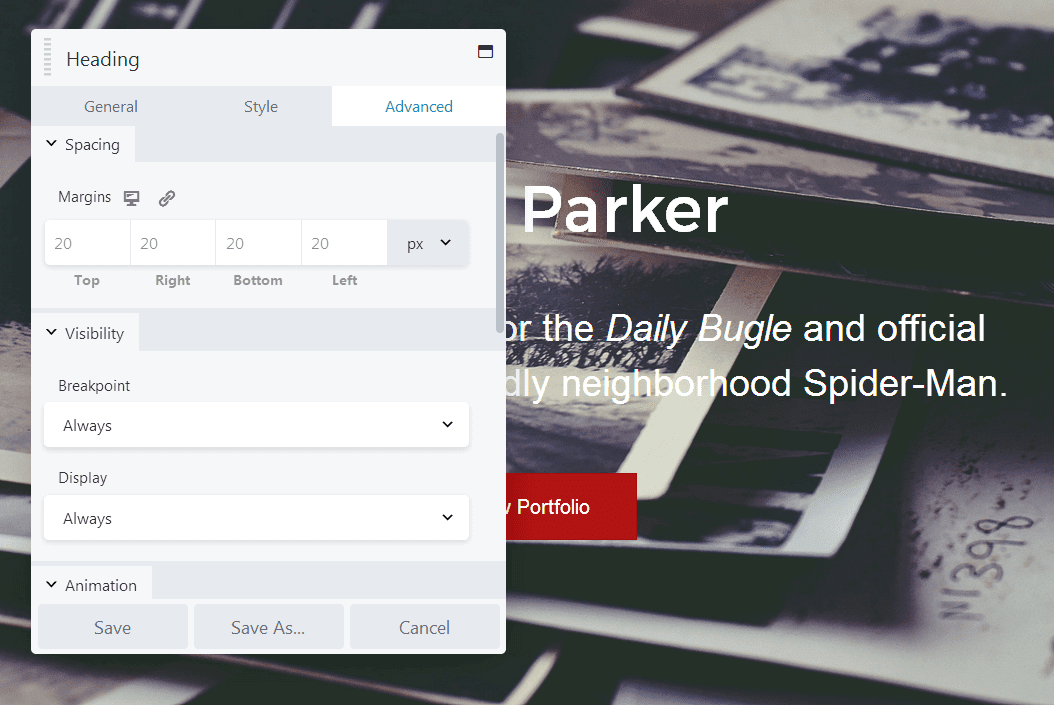
You can configure various visibility settings, such as the ability to choose from a long list of animations and set each animation's delay and duration. You can also hide the module for certain device sizes and restrict the module to only display to users who are logged in or out.
In Divi's Advanced section, you can add CSS ID and classes as well as custom CSS to each module.
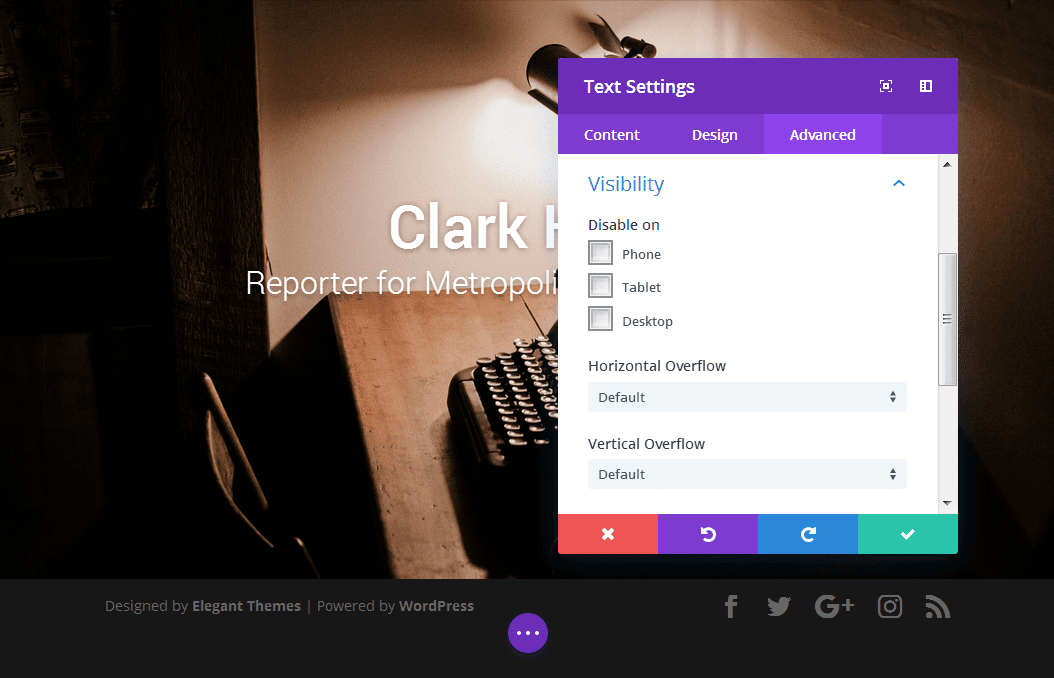
You can also hide the module on specific devices and customize the transition it uses.
Built-in Layout Templates in the Beaver Builder vs Divi debate 🚧
When you build a page, you can start from scratch or use a prebuilt layout template and tweak it. Both Beaver Builder and Divi offer a range of templates to choose from.
Beaver Builder offers a moderate number of layout templates* for you to choose from. The selection is diverse, and they're all well designed.
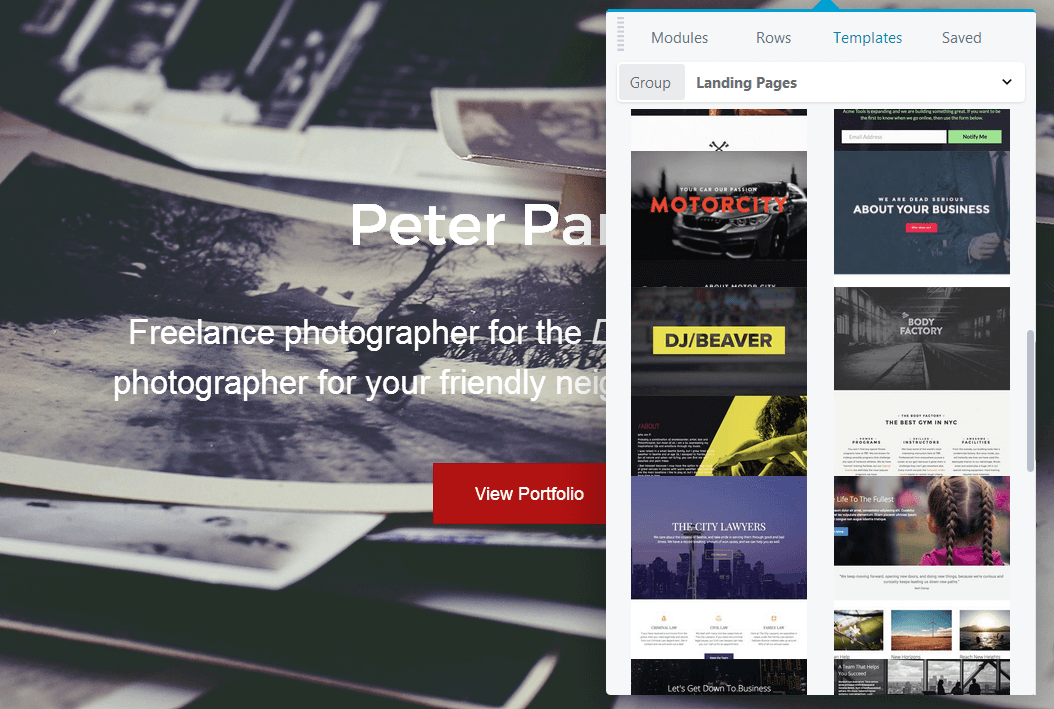
There are landing pages for different niches and purposes, such as selling products. There are also content pages for your blog, Team page, About page and more.
Divi has hundreds of templates for you to choose from. This screenshot shows the layout details for one of the templates.
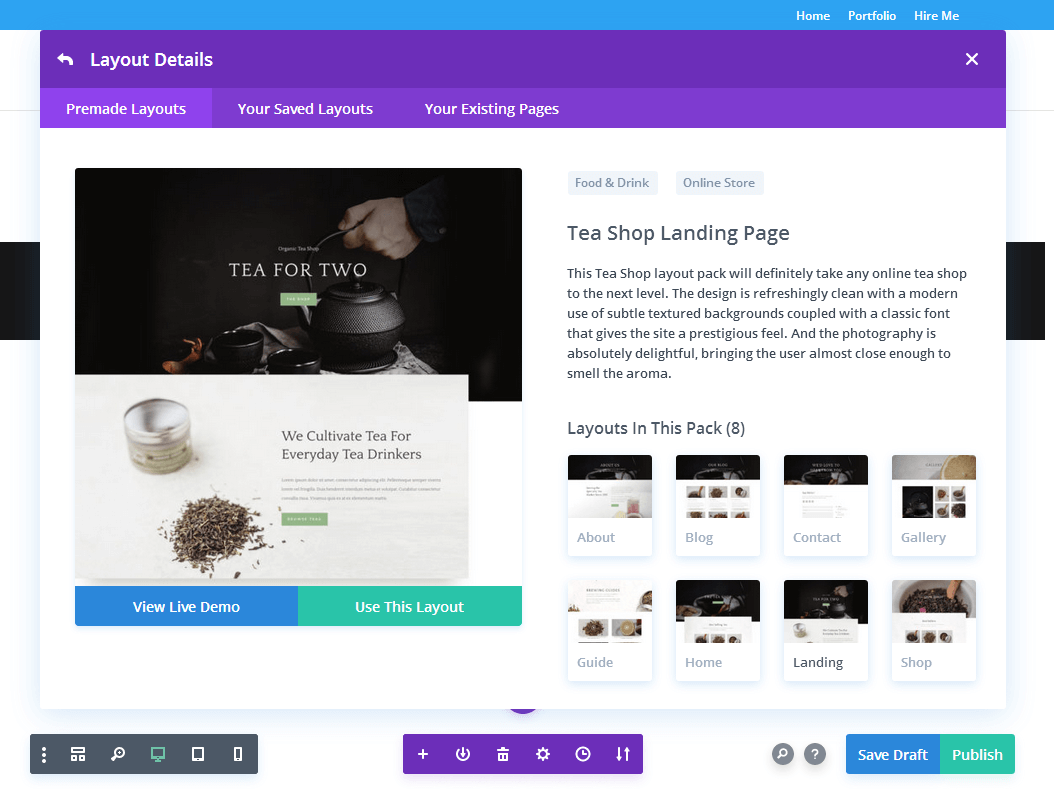
They cover a wide assortment of niches, purposes and content pages. So in the Beaver Builder vs Divi debate, both have a strong case here.
Deactivation 🔚
Some page builders rely on shortcodes to add modules to your pages. They surround your content in these shortcodes, but they aren't visible as long as the page builder is active on your site. But some page builders leave these codes behind when you deactivate to them, which can create a lot of work for you, both to remove the shortcodes and to retrieve the content they once displayed.
Beaver Builder is renowned for being one of those page builders that preserves your content when you deactivate the plugin. The layouts and background effects are lost, but the text and foreground images remain. This screenshot shows a Beaver Builder row on the left and the same row on the right after deactivation.

It makes transferring content to a new page builder quick and simple.
Divi, on the other hand, is famous for being difficult to move away from. Your content will be littered with shortcodes should you choose to deactivate the theme or plugin.
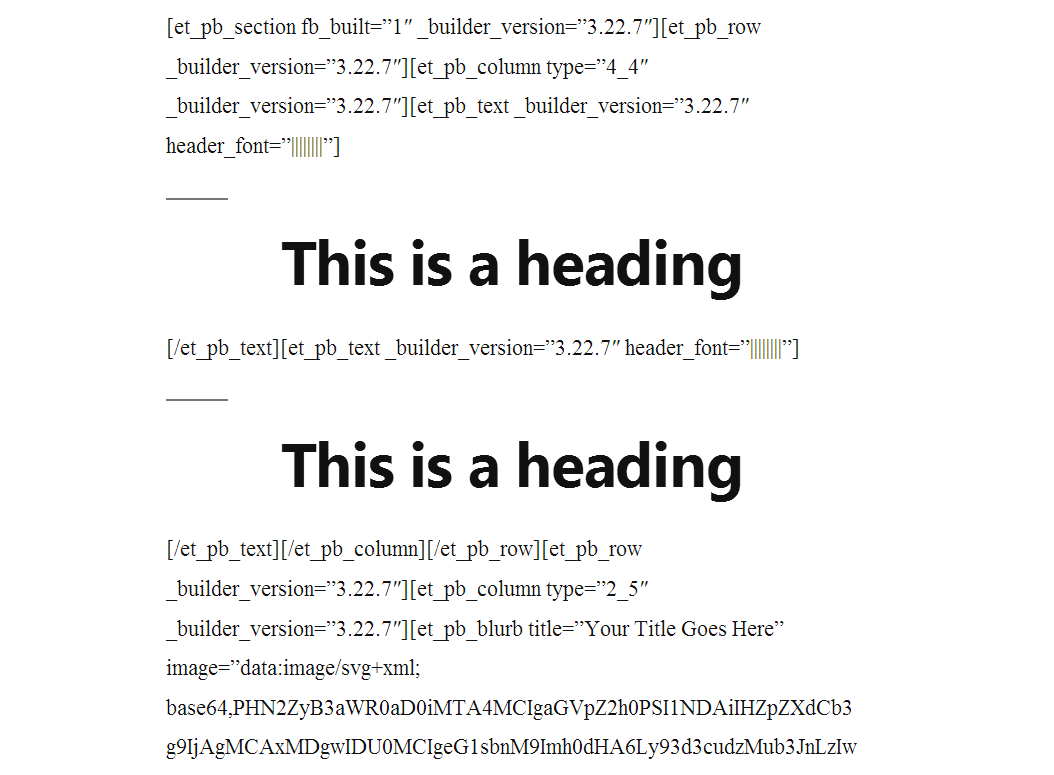
If you're not 100% all-in for a single page builder, Beaver Builder vs Divi is an easy choice. Beaver Builder will allow you the flexibility to switch to another page builder if you want while Divi locks you into their page builder only.
Founder and CEO of Elegant Themes Nick Roach promised to release a solution that would allow Divi users to move their content with ease back in 2015. Unfortunately, no such solution exists four years later. You'll need to rely on third parties to get the job done instead.
Beaver Builder vs. Divi Official Themes 📜
Beaver Builder offers the Beaver Builder Theme with two of its premium packages. Besides being fully integrated with the Beaver Builder plugin, this theme fully adopts WordPress' built-in live theme customizer. This screenshot shows the Customizer tabs for the Beaver Builder Theme.
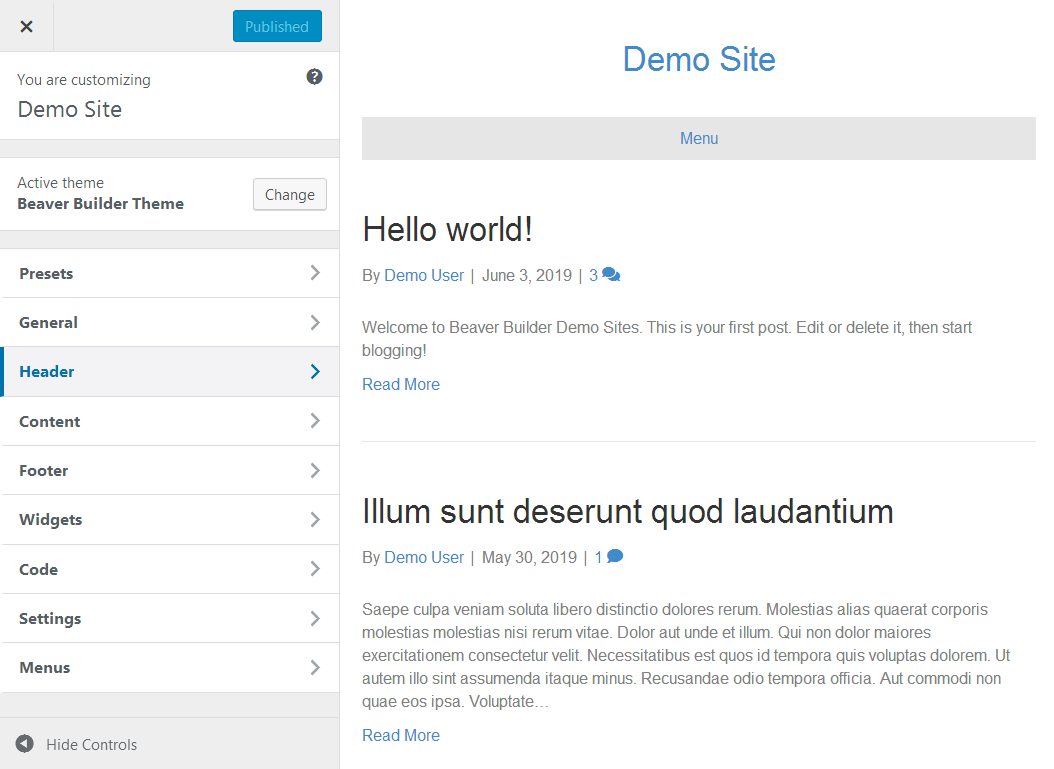
You can configure some of the default settings your site uses, such as its header and footer styles, fonts, text sizes, button styles, social links, and more.
The theme uses the familiar and well-supported Bootstrap CSS framework and is otherwise well-coded, ensuring your site performs well without being bogged down by your theme.
Divi offers the official Divi Theme, which has Divi Builder built into it. It has a wide assortment of theme options you can customize. They include everything from header, text, and default blog layout options to ad layouts. Its Customizer panel is shown in the following screenshot.
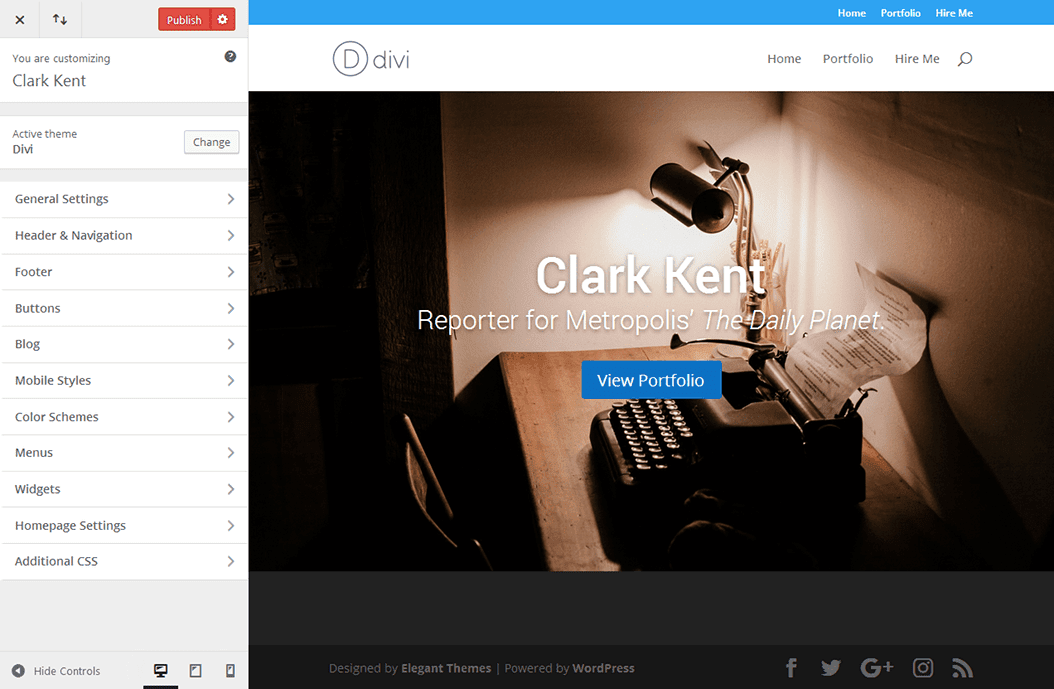
It's well designed, and you can customize certain theme options with the live theme customizer.
Beaver Builder vs. Divi Pricing & Support 💰
This is a core piece of the Beaver Builder vs Divi debate. Pricing and support will have a big impact on how expensive it is to build your website or client sites at scale. So let's dive into pricing!
Beaver Builder has a freemium version of the plugin, as stated earlier. This means you can get started for free and unlock more features when you upgrade to a premium plan.
There are three plans available:
- Standard at $99 – Unlocks unlimited site licenses as well as all premium modules and templates.
- Pro at $199 – Additionally unlocks the Beaver Builder theme and multisite capability.
- Agency at $399 – Additionally unlocks multisite network settings and white labeling.
All plans come with one year of support and updates, which you can renew annually at a 40% discount. All plans are also backed by a 30-day refund policy.
Support is available via a ticket system. You can also get in touch with other Beaver Builder users through the plugin's community on Facebook, Slack, and their own forums. They also offer an extensive knowledge base and tutorials on their blog.
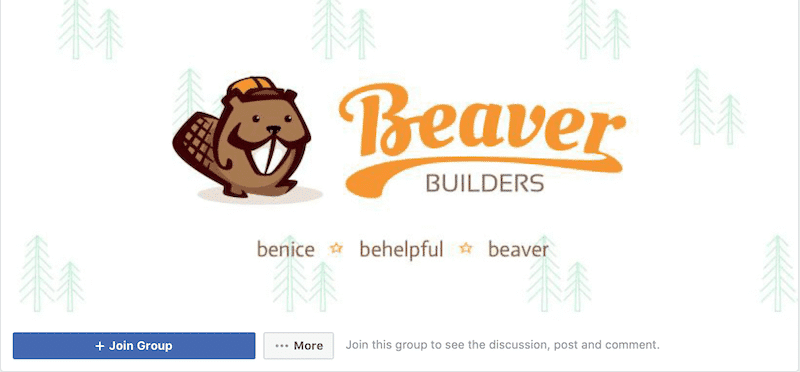
The Divi theme and Divi Builder plugin are not free products. They're part of Elegant Themes' membership program. Today, Elegant Themes offers a small collection of five themes and plugins, which cannot be purchased individually.
There are two plans:
- Yearly Access at $89/Year – Access to unlimited site licenses, all of ET's products, and support and updates for one year.
- Lifetime Access at $249 (One-Time Fee) – Access to everything the yearly plan offers but with a lifetime of support and updates.
Support is available via 24/7 through a live chat system. There are also well-developed docs and community forums. All plans are backed by a 30-day, money-back guarantee.
Wrapping Up 🌯
Since both of these plugins integrate seamlessly with themes made by the developers themselves, they can both be used as all-in-one solutions. They're also both compatible with almost any theme.
This is what makes it difficult to choose between them. 🏘️ Divi and the Divi Builder are great products that offer extended theme options, well-designed UIs, numerous content modules, and plenty of room for customization. Click To Tweet
Despite its pros, using the Divi Builder is a little slow in comparison to other page builders. Launching the page builder works fine for the most part, but operations such as inserting new modules and opening existing ones can sometimes take longer than they should. Almost everything seems to take a few extra clicks than with Beaver Builder.
It's also difficult to move away from Divi, as mentioned earlier. Supporters of Divi's heavy use of shortcodes state it shouldn't matter how many shortcodes are left when you deactivate the page builder since you'll need to rebuild pages anyway. However, you'll still need to go through the trouble of removing each shortcode from your content before you copy and paste it into a new editor. This will be especially cumbersome if you used Divi on blog posts.
Beaver Builder, on the other hand, is extremely fast to work with, and it offers an intuitive UI, well-designed content modules and enough theme options for you to customize your site to your liking. The code is clean, and you won't have a mess of shortcodes if you plan on moving away from the plugin.
You can demo the premium version of Beaver Builder or download the free version to give it a try. Elegant Themes offers a Divi demo as well.
Try Beaver Builder* | Try Divi
And if you want help setting up WordPress page builder plugins or need more general site maintenance and care plans, we here at WP Buffs got you covered too. Whether it's site speed or security you want to get a handle on, we can manage it for you.
Want to give your feedback or join the conversation? Add your comments 🐦 on Twitter .
Dive How To Rezise Photo Blog Divi
Source: https://wpbuffs.com/wordpress-page-builder-duel-beaver-builder-vs-divi/
Posted by: toppandever.blogspot.com

0 Response to "Dive How To Rezise Photo Blog Divi"
Post a Comment